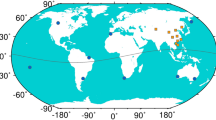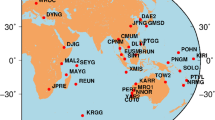Abstract
A simple way of improving the Global Navigation Satellite Systems (GNSS) slant ionospheric correction from Vertical Total Electron Content (VTEC) models is presented. In many GNSS applications, a mapping function is required to convert from VTEC, which may be provided in Global Ionospheric Maps (GIMs), to Slant TEC (STEC). Typical approaches assume a single ionospheric shell with constant height, which is unrealistic, especially for low-elevation signals. To reduce the associated conversion error, we propose the Barcelona Ionospheric Mapping Function and its first implementation at northern mid-latitudes (BIMF-nml). BIMF is based on a climatic prediction of the distribution of the topside vertical electron content fraction of VTEC (hereinafter µ2). BIMF is convenient to be applied since no external data are required in practice. To evaluate its performance, we use as independent reference the STEC difference (so-called dSTEC) values directly measured from mid-latitude dual-frequency Global Positioning System (GPS) receivers that have not been used in the computation of the VTEC GIMs under assessment. It is shown that the use of BIMF improves the GIM STEC estimation compared to the single-layer assumptions. This is the case for the mapping functions used by the International GNSS Service (IGS) and Satellite-Based Augmentation Systems (SBAS). This improvement is valid not only for the UPC GIMs, up to 15% for the year 2014, but especially for the GIMs of other analysis centers, such as those produced by CODE and JPL, up to 32 and 29%, respectively.














Similar content being viewed by others
Change history
20 July 2020
In the original article, some typos regarding Eq. (3) and Table��9 are introduced.
References
Afraimovich EL, Astafyeva EI, Oinats AV, Yasukevich YV, Zhivetiev IV (2008) Global electron content: a new conception to track solar activity. Ann Geophys 26:335–344
Birch MJ, Hargreaves JK, Bailey GJ (2002) On the use of an effective ionospheric height in electron content measurement by GPS reception. Radio Sci. https://doi.org/10.1029/2000RS002601
Dow JM, Neilan RE, Rizos C (2009) The international GNSS service in a changing landscape of global navigation satellite systems. J Geodesy 83(3):191–198
European Commission (2016) European GNSS (Galileo) open service ionospheric correction algorithm for galileo single frequency users, Issue 1.2
Feltens J, Angling M, Jackson-Booth N, Jakowski N, Hoque M, Hernández-Pajares M, Aragón-Àngel À, Orús R, Zandbergen R (2011) Comparative testing of four ionospheric models driven with GPS measurements. Radio Sci 46(6):RS0D12
Hernández-Pajares M, Juan JM, Sanz J (1997) Neural network modeling of the ionospheric electron content at global scale using GPS data. Radio Sci 32(3):1081–1089
Hernández-Pajares M, Juan JM, Sanz J (1999) New approaches in global ionospheric determination using ground GPS data. J Atmos Solar Terr Phys 61(16):1237–1247
Hernández-Pajares M, Juan JM, Sanz J, Colombo OL (2000a) Application of ionospheric tomography to real-time GPS carrier-phase ambiguities resolution, at scales of 400–1000 km and with high geomagnetic activity. Geophys Res Lett 27(13):2009–2012
Hernández-Pajares M, Juan JM, Sanz J (2000b) Improving the Abel inversion by adding ground GPS data to LEO radio occultations in ionospheric sounding. Geophys Res Lett 27(16):2473–2476
Hernández-Pajares M, Juan JM, Sanz J, Colombo OL (2002) Improving the real-time ionospheric determination from GPS sites at very long distances over the equator. J Geophys Res 107(A10):SIA 10-1–SIA 10-10
Hernández-Pajares M, Juan JM, Sanz J, Orus R, García-Rigo A, Feltens J, Komjathy A, Schaer SC, Krankowski A (2009) The IGS VTEC maps: a reliable source of ionospheric information since 1998. J Geodesy 83(3):263–275
Hernández-Pajares M, Juan JM, Sanz J, Aragón-Àngel À, García-Rigo A, Salazar D, Escudero M (2011) The ionosphere: effects, GPS modeling and the benefits for space geodetic techniques. J Geodesy 85(12):887–907
Hernández-Pajares M, Roma-Dollase D, Krankowski A, García-Rigo A, Orús-Pérez R (2017a) Methodology and consistency of slant and vertical assessments for ionospheric electron content models. J Geodesy 91(12):1405–1414
Hernández-Pajares M, Garcia-Fernàndez M, Rius A, Notarpietro R, Engeln AV, Olivares-Pulido G, Aragón-Àngel À, García-Rigo A (2017b) Electron density extrapolation above F2 peak by the linear Vary-Chap model supporting new Global Navigation Satellite Systems-LEO occultation missions. J Geophys Res 122(8):9003–9014
Hoque MM, Jakowski N (2013) Mitigation of ionospheric mapping function error. Proc. ION GNSS + 2013, Nashville Convention Center, Nashville, Tennessee, USA, September 16–20, 1848–1855
Juan JM, Rius A, Hernández-Pajares M, Sanz J (1997) A two-layer model of the ionosphere using Global Positioning System data. Geophys Res Lett 24(4):393–396
Klobuchar JA (1987) Ionospheric time-delay algorithm for single-frequency GPS users. IEEE Trans Aerosp Electron Syst 23(3):325–331
Komjathy A, Langley RB (1996) The effect of shell height on high precision ionospheric modelling using GPS. Proceedings of the 1996 IGS Workshop, Silver Spring, Maryland, USA, March 19–21, 193–203
Komjathy A, Sparks L, Mannucci AJ, Coster A (2004) The ionospheric impact of the October 2003 storm event on WAAS. Proc. ION GNSS 2004, Institute of Navigation, California, USA, September 21–24, 1298–1307
Lejeune R, El-Arini MB, Doherty P, Klobuchar J, De Paula E, Rodrigues F, Canavitsas A (2003) Performance of SBAS ionospheric estimation in the equatorial region. Proc. ION GPS/GNSS 2003, Institute of Navigation, Portland, Oregon, USA, September 9–12, 1658–1669
Niranjan K, Srivani B, Gopikrishna S, Rama Rao PVS (2007) Spatial distribution of ionization in the equatorial and low-latitude ionosphere of the Indian sector and its effect on the pierce point altitude for GPS applications during low solar activity periods. J Geophys Res 112(A5):A05304
Orús R, Hernández-Pajares M, Juan JM, Sanz J (2005) Improvement of global ionospheric VTEC maps by using Kriging interpolation technique. J Atmos Solar Terr Phys 67(16):1598–1609
Roma-Dollase D, Hernández-Pajares M, Krankowski A et al (2017) Consistency of seven different GNSS global ionospheric mapping techniques during one solar cycle. J Geodesy. https://doi.org/10.1007/s00190-017-1088-9
Sakai T, Yoshihara T, Saito S, Matsunaga K, Hoshinoo K, Walter T (2009) Modeling Vertical Structure of Ionosphere for SBAS. Proc. ION GNSS 2009, Savannah International Convention Center, Savannah, Georgia, USA, September 22–25, 1257–1267
Zus F, Deng Z, Heise S, Wickert J (2016) Ionospheric mapping functions based on electron density fields. GPS Solutions 21(3):873–885
Acknowledgements
This research has been generated within the context of the AUDITOR project (Advanced MultiConstellation EGNSS Augmentation and Monitoring Network and its Application in Precision Agriculture), funded by the European Union’s H2020 Programme, under grant agreement number 687367. The first author is grateful to the financial support of the China Scholarship Council. The authors are also grateful to the International GNSS Service. The open-data open-product scientific organizations always provide a professional and friendly framework for collaboration. The authors would like to thank anonymous reviewers for their valuable comments and suggestions that improved the quality of the paper. The second author is indebted to Dr. Raül Orús-Pérez for his suggestions for improving the previous version of the manuscript.
Author information
Authors and Affiliations
Corresponding author
Appendices
Appendix A
Appendix B
Rights and permissions
About this article
Cite this article
Lyu, H., Hernández-Pajares, M., Nohutcu, M. et al. The Barcelona ionospheric mapping function (BIMF) and its application to northern mid-latitudes. GPS Solut 22, 67 (2018). https://doi.org/10.1007/s10291-018-0731-0
Received:
Accepted:
Published:
DOI: https://doi.org/10.1007/s10291-018-0731-0




